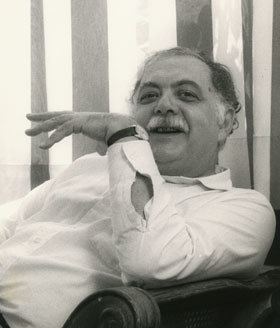Children Nicolas, Anna Louise Relatives Andre Grabar | Name Oleg Grabar Spouse Terry Grabar (m. 1949) | |
 | ||
Born November 3, 1929 Strasbourg, France Occupation art historian, archeologist Awards Guggenheim Fellowship for Social Sciences, US & Canada Books Formation of Islamic art, Islamic Art and Architectu, The Mediation of Ornam, The shape of the holy, Masterpieces of Islamic Art: The D Similar People | ||
Oleg Grabar (Part 1)
Oleg Grabar (November 3, 1929 – January 8, 2011) was a French-born art historian and archeologist, who spent most of his career in the United States, as a leading figure in the field of Islamic art and architecture.
Contents
- Oleg Grabar Part 1
- Oleg Grabar Part 2
- Academic career
- Research
- Personal life
- Honors
- Selected works
- References
Oleg Grabar (Part 2)
Academic career
Grabar attended the University of Paris, where he studied ancient, medieval, and modern history, before moving to the US in 1948. He completed degrees from both Harvard and the University of Paris in 1950. In 1955, he obtained a PhD from Princeton University.
He served on the faculty of the University of Michigan in 1954-69, before moving to Harvard University as a full professor. In 1980, Grabar became Harvard's first Aga Khan Professor of Islamic Art and Architecture. He was a founding editor of the journal Muqarnas in 1983. He became emeritus from Harvard in 1990, and then joined the School of Historical Studies at the Institute for Advanced Study, becoming emeritus there in 1998.
According to the President of the Historians of Islamic Art Association, "Grabar transformed the fields of Islamic art, architecture and archaeology through his myriad scholarly works, general textbooks, and through training and inspiring many generations of undergraduate and graduate students at the University of Michigan and at Harvard."
Research
Grabar's archeological and scholarly research covered a wide range of Islamic studies across Africa, the Middle East, and Muslim Asia.
Early in his career, Grabar spent two years (1953-1953 and 1960–1961) at the American School of Oriental Research in Jerusalem. From 1964 to 1972, he directed excavations on a Medieval Islamic town at Qasr al-Hayr al-Sharqi, Syria, work later described in a two-volume book he coauthored, City in the Desert, Qasr al-Hayr East. Other major books in English include The Shape of the Holy (Princeton, 1996), The Mediation of Ornament (Princeton, 1992), The Great Mosque of Isfahan (NYU, 1990), and The Formation of Islamic Art (Yale, 1973).
Oleg Grabar also did scholarly work on the Persian miniature. With Sheila Blair, he coauthored an illustrated study of a major Shahnameh manuscript, Epic Images and Contemporary History: The Illustrations of the Great Mongol Shahnama (Chicago, 1980). He was also a noted scholar of the Dome of the Rock, after the appearance of his article "The Umayyad Dome of the Rock in Jerusalem." His work Penser l'art islamique : une esthétique de l'ornement denotes also reflections on the nature of Islamic art.
Personal life
Grabar was the son of the renowned Byzantinist André Grabar. Oleg Grabar and his wife Terry, a retired English professor, were married for 59 years. They had two children, Nicolas and Anne Louise, and three grandchildren, Henry, Olivia, and Margaret.
Honors
Grabar received many honors during his lifetime, including the Charles Lang Freer Medal in 2001 and, in 2010, the Chairman's Award at the Aga Khan Award for Architecture ceremony in Doha, where he made what was perhaps his last public speech.
Selected works
In a statistical overview derived from writings by and about Oleg Grabar, OCLC/WorldCat encompasses roughly 200+ works in 500+ publications in 13 languages and 15,000+ library holdings.
